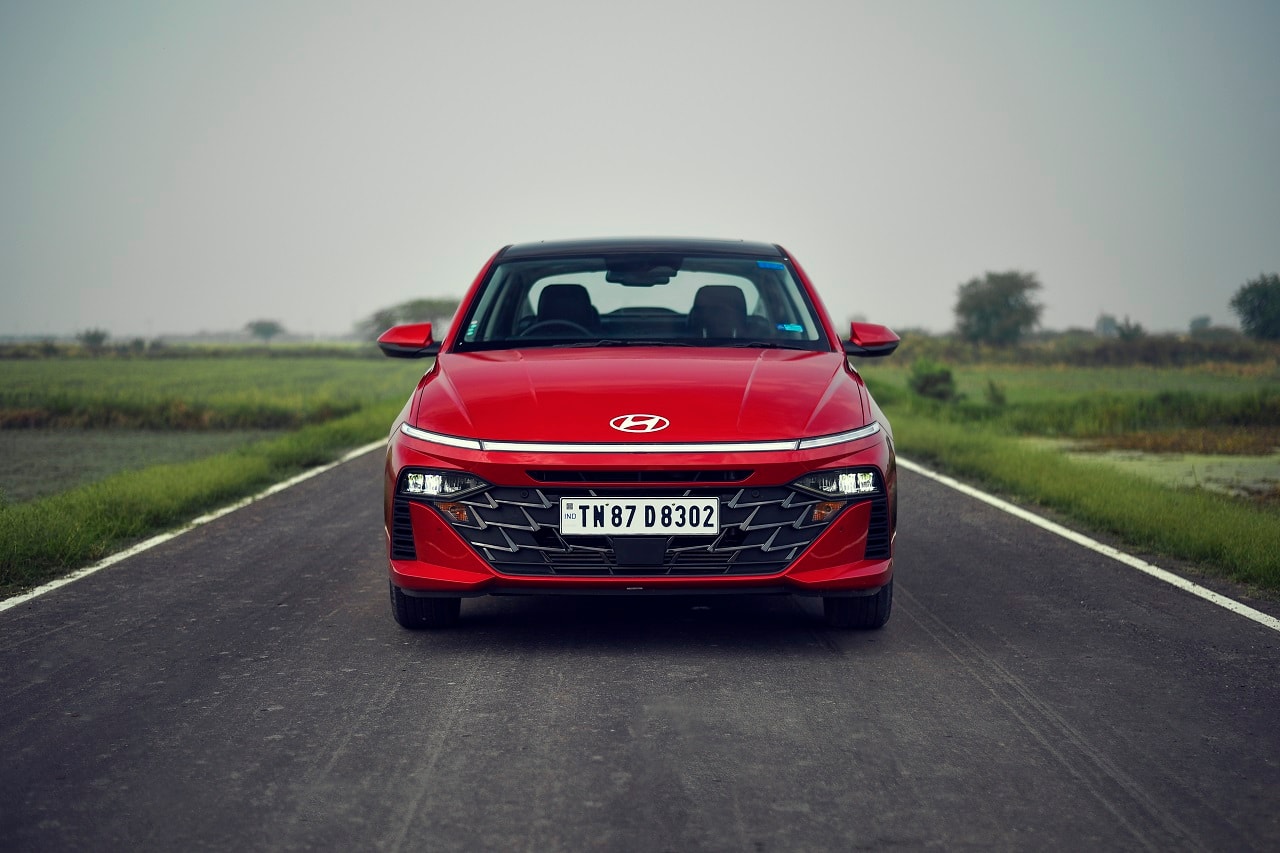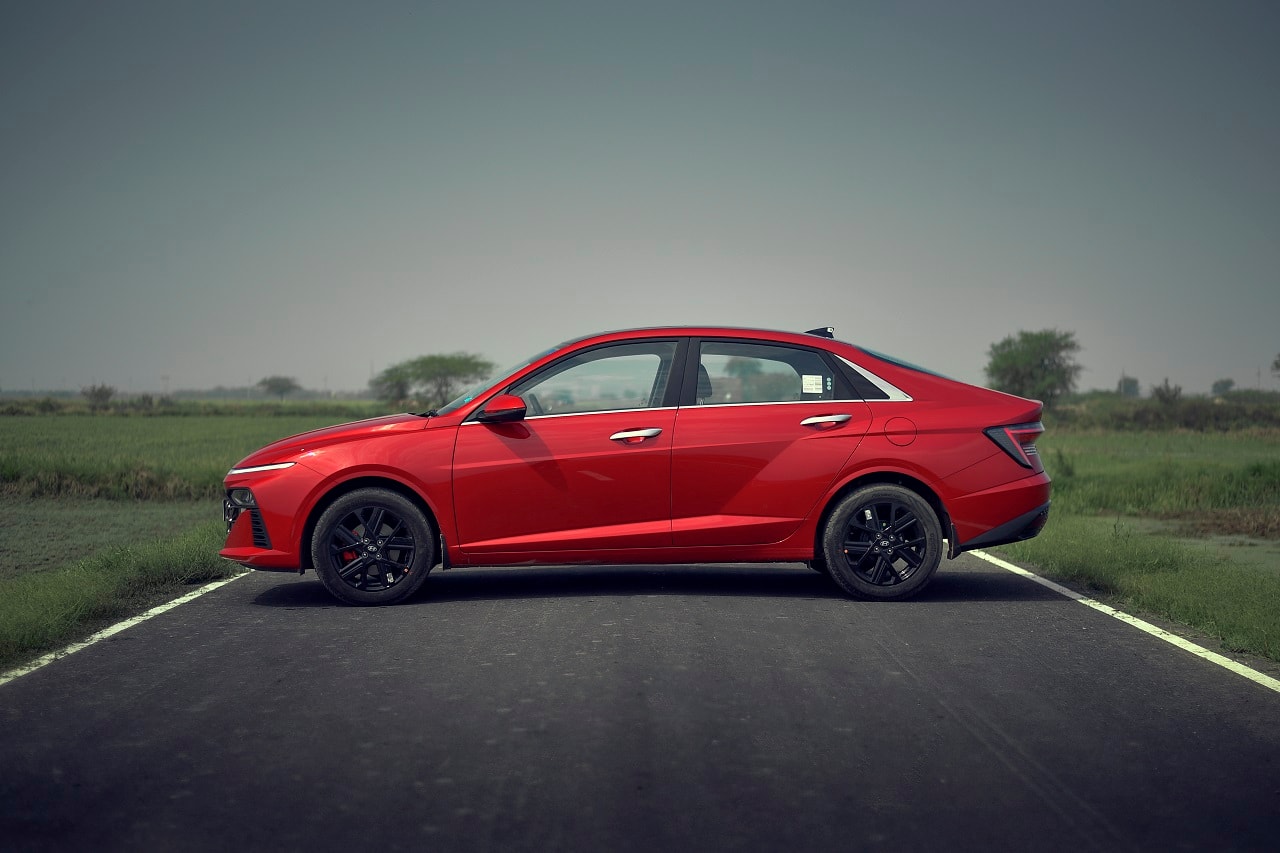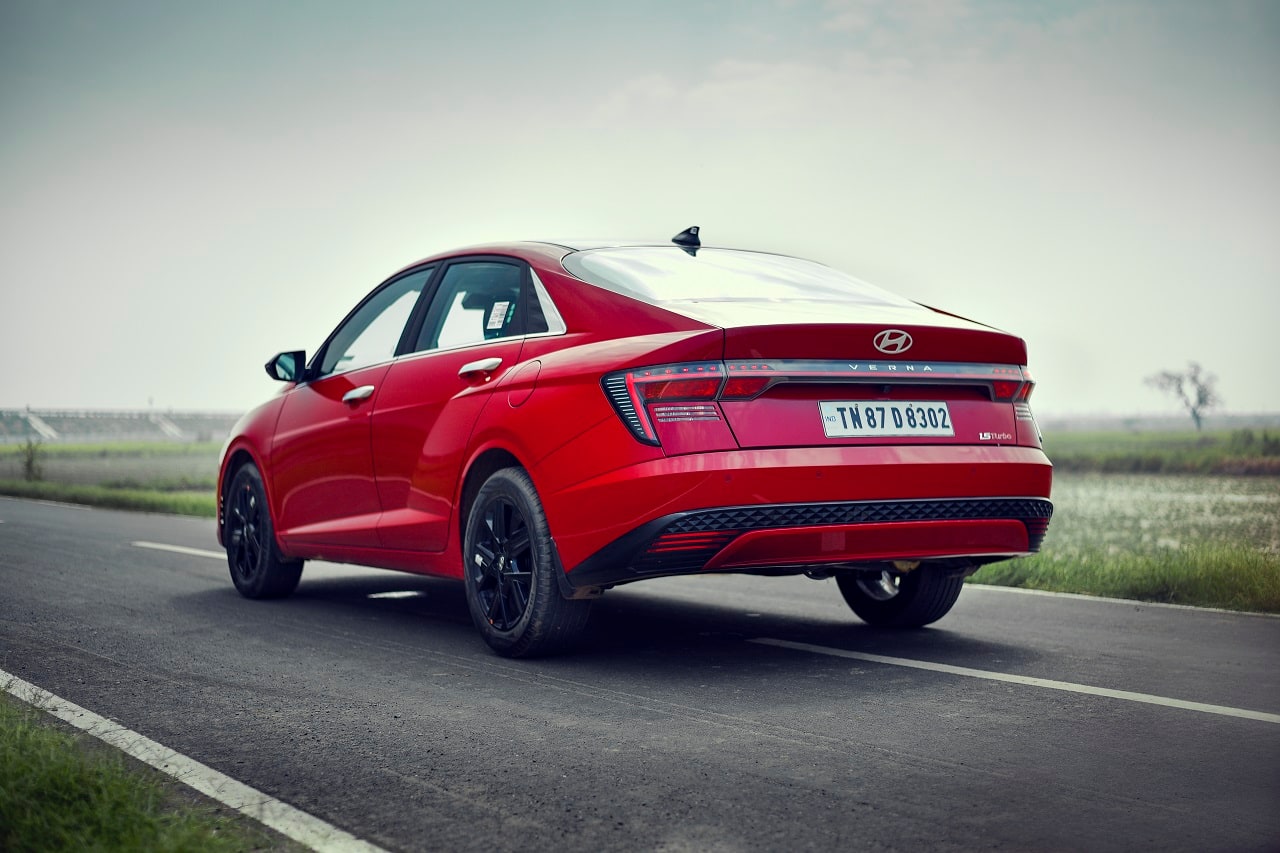



Here’s an astonishing fact. The cheapest diesel sedan being sold in India today is a Mercedes-Benz A200d, which can be yours for the princely sum of Rs 44 lakh, ex-showroom. That’s right – if you want a cheaper diesel-powered sedan, you can only buy one from the used-car market.
This is a result of various emissions-based rulings in India over the years, which have made it difficult for manufacturers to make small-capacity diesel cars adhere to these norms without making the engines extremely expensive.
So the all-new Verna comes with a petrol engine only, like every other car in its segment.
Sedan sales have dwindled in India to a point where there’s a question mark hanging over the segment, but Hyundai is bullish – it wants to sell twice as many of the new Vernas as it did the previous generation model, and it thinks the segment has scope to grow. To that end, it’s gone all out with the 2023 Verna, which is longer, wider and more packed with tech and features than its predecessors.
It’s also a very good looking car – probably the best in the segment. It sticks to Hyundai's ‘sensuous sportiness’ design language, and looks a lot like the Elantra that is currently sold in foreign markets. There’s a slick LED strip running the width of the nose, and the headlamps are now lower down in the grille. The profile is sleek and sporty, with a ‘fastback’ curve in the roof, and the character lines on its side are very prominent and sporty; the attractive alloy wheels fill out the wheel arches nicely.
In the back, the LED brake light runs the width of the rear and looks great; it’s very well integrated into the boot, too. The shark fin antenna on the roof rounds off the sportiness, and I couldn’t help but feel that Hyundai missed a trick by not offering a spoiler on the top-end version of the car. Nevertheless, there’s no doubt that this is the most striking car in its segment, visually.
 New Hyundai Verna
New Hyundai VernaThe Verna’s cabin, while not as striking as its exterior, is top-notch as well. It has a huge digital instrument panel that merges into an equally large infotainment screen, and both are high resolution and display a wealth of information; the instrumentation is from the older Verna, while the infotainment is the latest generation.
The steering wheel is of a two-spoke design, which is novel for the segment; it’s crammed with buttons and controls of every variety, which does put a lot of features within reach, but can also be confusing to read and figure out at first. The central console is configurable; with the press of a button, you can switch between the A/C controls and various multimedia features. The physical knobs operate either the temperature/fan speed or volume/channel, depending on what control has been set on the panel, and that’s a very neat touch.
The driver gets electric forward/backward adjustment, but the height adjustment is manual. The front seats are also heated and cooled – another great feature. They’re covered in faux leather (in the top spec cars) and are comfortable enough, save for a little lack of thigh support. The plastics used are good enough, but they could have felt a bit more premium.
The second row of seats is also quite comfortable, with the scooped-out roof line offering decent headroom, and the lengthened wheelbase giving you more leg room as well. Again, the seats are of good quality but there’s some thigh support missing – and you also sit quite low down in the car. Two adults will be perfectly fine here, but three may feel a bit squeezed. There are lots of storage spaces both front and back, and the boot is huge at 528 litres --the largest in the class. It’ll easily swallow the luggage of a family of four.
 New Hyundai VernaFeature set
New Hyundai VernaFeature set The feature set is impressive, as you would imagine. There’s a sunroof, connected car tech, wireless phone charging, climate control, a Bose audio system, 64-colour ambient lighting, automatic tailgate opening, multi-language support for the user interface and several more. Thankfully it gets both USB A and C connectors! Six airbags are standard, and the Verna is also loaded with Level 2 ADAS features -- lane assist, front collision assist, blind-spot warning, adaptive cruise control, rear cross-traffic assist, high-beam assist, driver fatigue warning and so on. Make no mistake, this is the most tech-laden and advanced car in its class, and although the ADAS features take some getting used to (especially if you’ve never experienced them in other cars), they work very well.
As mentioned, there is no diesel option offered any longer. A new 1.5-litre turbo-petrol replaces the older 1-litre turbo-petrol, and it offers a very healthy 158 bhp alongside 253 Nm of torque; you can option either a seven-speed DCT or a six-speed manual. You also get a 1.5-litre four-cylinder naturally aspirated petrol engine with 113 bhp and 144 Nm, and that one comes with a CVT or a six-speed manual. This is the combination that Hyundai says has received the most bookings, by the way. It’s also not a new engine, having been offered in the updated Verna of the previous generation.
This powerplant will be more than enough for most buyers. It’s very refined and quiet at startup and at idle, and when you get it moving, there’s a sense of serenity to it that’s praiseworthy. It’s not an engine that likes to be pushed too hard immediately, responding better to a gradual throttle input than a mashing of the accelerator.
It’s very agreeable in city traffic and at slow speeds, purring gently, and when you need to get moving faster, it’s up to the job too, becoming lively past the 3,000 rpm mark and going on to triple-digit speeds. Acceleration isn’t lightning quick (for that you need the turbo-petrol), but if you modulate the pedal correctly, you’ll find it’s more than sufficient for most purposes; clearly Hyundai has tuned this engine for everyday usability. There are also three driving modes on offer – eco, normal and sport – and they alter the throttle response accordingly.
 New Hyundai VernaThe ride
New Hyundai VernaThe rideEveryday use is also what the Verna has been set up for in the handling and ride stakes. The steering wheel is light at city speeds and does weigh up nicely as you step on the gas, and it doesn’t require too many corrections while you’re driving either. The brakes (discs all-round on the top-end cars) work well, but the pedal lacks a certain sharpness that is present in cars like the VW Virtus.
The ride on offer is firmer than the older car, and it feels much better weighed down as well. On smooth roads, the car feels very planted, and switching lanes at higher speeds is an easy affair, and when you engage in some fast cornering, the Verna tackles the bends confidently, with little body roll; the tyres do feel like they could have been grippier, however. When you encounter rougher surfaces, you can feel some of the bigger bumps in the cabin, but as you begin to drive faster, that gets ironed out.
The latest Verna is now more expensive (Rs 10.9 lakh to Rs 17.4 lakh, ex-showroom) than the older car by a couple of lakh rupees, which at face value is quite a lot. However, you do get a lot of car for that money – safety and convenience features, ADAS, more space, better build and practicality and far better engines, to name the most significant.
If you absolutely must have a diesel sedan, well, you're out of luck in this segment; the turbo-petrol version with the DCT does offer itself up as an option if you want more power and torque in your daily driving experience. All told, the new Hyundai Verna is the most accomplished car in the segment when all factors are taken into consideration – and it really does have the potential to make sedans popular again.
Discover the latest Business News, Sensex, and Nifty updates. Obtain Personal Finance insights, tax queries, and expert opinions on Moneycontrol or download the Moneycontrol App to stay updated!
Find the best of Al News in one place, specially curated for you every weekend.
Stay on top of the latest tech trends and biggest startup news.